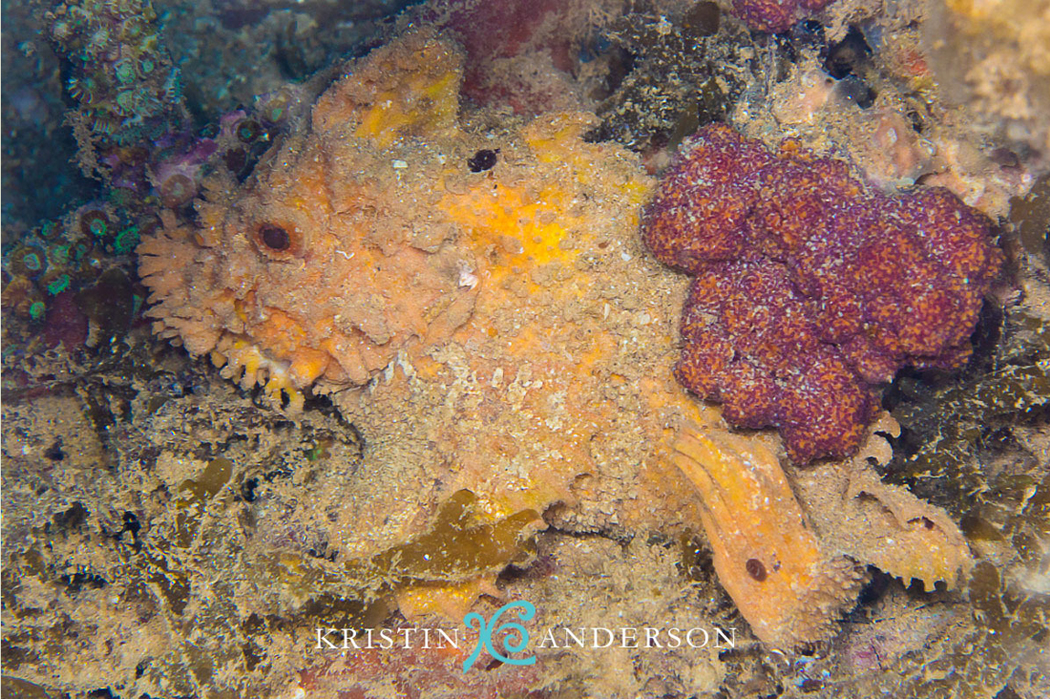Pillow Velvetfish, Paraploactis pulvinus Poss & Eschmeyer 1978

A Pillow Velvetfish, Paraploactis pulvinus, North West Cape, Western Australia, December 2019. Source: Kristin Anderson / iNaturalist.org. License: CC By Attribution-NonCommercial
Summary:
A mottled yellowish to reddish velvetfish with a very steep snout, and no prickles on the underside of the lower jaw (mandible). The ventral surface of the mandible is extremely fleshy, cirri are entirely absent along its inner margin, and those along the outer margin are very fleshy and flattened. The snout has large, fleshy, and extensively branched cirri, with very large cirri in larger patches on the tip of the snout and across the lachrymal bones, and smaller cirri in a smaller patch on the nasal bones.
Cite this page as:
Bray, D.J. 2020, Paraploactis pulvinus in Fishes of Australia, accessed 27 Jun 2025, https://fishesofaustralia.net.au/Home/species/1769
Pillow Velvetfish, Paraploactis pulvinus Poss & Eschmeyer 1978
More Info
|
Distribution |
Exmouth Gulf, Western Australia, to Captain Billy Creek, Cape York, Queensland. The species also occurs on Papua New Guinea. Inhabits muddy/silty areas. |
|
Features |
Dorsal fin XIII-XIV, 9-10; Anal fin I, 8-9; Pectoral fin 14; Vertebrae 27; Gill rakers 0-3 + 7-9 = 7-11, all rakers very short, stubby; Lateral line scales 12-14. Ventral surface of lower jaw smooth, fleshy, without villi, 6-11 fleshy cirri confined to row along outer margin. Large fleshy cushion pad on isthmus about 1/2 to 3/4 as wide as long, abutting fleshy posterior border of lower jaw anteriorly so as to form a disc-like pad on ventral side of head. Large tuft of elongate fleshy cirri across nasal bones, on lower cheek anterior to lowermost preopercular spine, and a few near proximal end of branchiostegals. Snout very steep with numerous elongate fleshy cirri; those in larger patch across tip of snout and lachrymal bones longer than those in smaller patch on nasal bones. Lachrymal bone (infraorbital 1) with three spines, anterior-most as inconspicuous lump, posterior two with points widely divergent. Heavily ossified knobs, spines, and ridges on head, particularly in interorbit. Papillose cirri on pectoral fin and on spines of dorsal fin, very large on first three spines. |
|
Fisheries |
Sometimes taken as by-catch in commercial trawls. |
|
Etymology |
The specific name is from the Latin "pulvinus", meaning pillow, in reference to the fleshy pad upon which this fish rests its head. |
|
Species Citation |
Paraploactis pulvinus Poss & Eschmeyer 1978, Proceedings of the California Academy of Sciences 41(18): 413, figs. 2,8.Type locality: Exmouth Gulf, Western Australia. |
|
Author |
Bray, D.J. 2020 |
|
Resources |
Pillow Velvetfish, Paraploactis pulvinus Poss & Eschmeyer 1978
References
Allen, G.R. 1997. Marine Fishes of Tropical Australia and South-east Asia. Perth : Western Australian Museum 292 pp. 106 pls. (mentioned under Paraploactis intonsa)
Poss, S.G. 1999. Families Scorpaenidae, Caracanthidae, Aploactinidae. pp. 2291-2358 in Carpenter, K.E. & Niem, T.H. (eds). The Living Marine Resources of the Western Central Pacific. FAO Species Identification Guide for Fisheries Purposes. Rome : FAO Vol. 4 pp. 2069-2790.
Poss, S.G. & Eschmeyer, W.N. 1978. Two new Australian velvetfishes, genus Paraploactis (Scorpaeniformes : Aploactinidae) with a revision of the genus and comments on the genera and species of the Aploactinidae. Proceedings of the California Academy of Sciences 41(18): 401-426 figs 1-14 See ref at BHL




